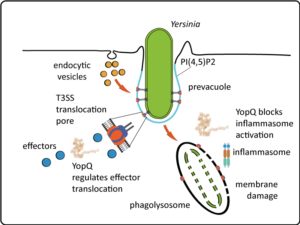P1 – Control of Yersinia translocon activity and immune recognition
Principal Investigator
Prof. Dr. med. Martin Aepfelbacher
University Medical Center Hamburg-Eppendorf
Institute of Medical Microbiology, Virology and Hygiene

Project Summary
 The T3SS/injectisome of Yersinia enterocolitica is a molecular machine that injects effector proteins into host cells to support the bacterial infection strategy. The injectisome directly connects to host cells via a translocon/pore complex, that serves as an entry gate for the effectors. Simultaneously attached to the T3SS needle tip and integrated into the host cell membrane, the translocon is subject to multi-layered regulation by bacterial and host cell factors. YopQ/YopK is a Yersinia effector that controls both, activity and immune recognition of the translocon from within the host cells.
The T3SS/injectisome of Yersinia enterocolitica is a molecular machine that injects effector proteins into host cells to support the bacterial infection strategy. The injectisome directly connects to host cells via a translocon/pore complex, that serves as an entry gate for the effectors. Simultaneously attached to the T3SS needle tip and integrated into the host cell membrane, the translocon is subject to multi-layered regulation by bacterial and host cell factors. YopQ/YopK is a Yersinia effector that controls both, activity and immune recognition of the translocon from within the host cells.
Despite the critical role of YopQ/YopK in function and immune recognition of the Yersinia translocon, its direct interaction partners and molecular mode of action are unknown.
The overall goal of P1 is to determine the molecular mode by which Y. enterocolitica YopQ controls activity and immune recognition of the T3SS translocon. To this end, i) the dynamics of bacterially translocated YopQ in host cells and its correlation with function, formation, degradation and/or immune sensing of the translocon will be visualized at the highest spatial and temporal resolution; ii) the macrophage interaction partners of YopQ/YopK will be identified by affinity purification and verified in functional assays, and iii) the structure-function relationship of YopQ in terms of its intracellular spatiotemporal dynamics, interaction with binding partners, and effects on translocon activity and immune recognition will be investigated.
Methods to be applied include: sCRISPR/Cas mediated mutagenesis and gene editing of Yersinia; affinity purification and mass spectrometric analysis of host-pathogen protein complexes; in vitro protein-protein interaction; super-resolution fluorescence microscopy of bacterial and host proteins in fixed and living macrophages.
References
Brodsky IE, Palm NW, Sadanand S, Ryndak MB, Sutterwala FS, Flavell RA, Bliska JB, Medzhitov R (2010) A Yersinia effector protein promotes virulence by preventing inflammasome recognition of the type III secretion system. Cell Host Microbe 7:376-87. Abstract
Dewoody RS, Merritt PM, Marketon MM (2013) Regulation of the Yersinia type III secretion system: traffic control. Front Cell Infect Microbiol 3:4. Abstract
(2018) Visualization of translocons in Yersiniatype III protein secretion machines during host cell infection. PLoS Pathog 14:e1007527. Abstract
Carsten A, Rudolph M, Weihs T, Schmidt R, Wurm CA, Diepold A, Virgilio Failla A, Wolters M, Aepfelbacher M (2021) Visualization of bacterial type 3 secretion system components down the molecular level by MINFLUX nanoscopy. bioRxiv doi: https://doi.org/10.1101/2021.09.27.461991. Abstract
(2022) Live imaging of Yersinia translocon formation and immune recognition in host cells. PLoS Pathog 18:e1010251. Abstract
